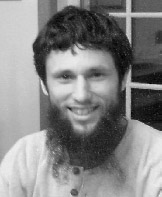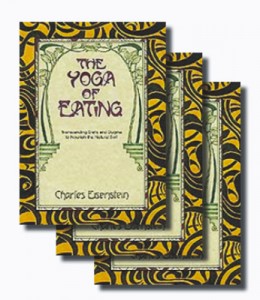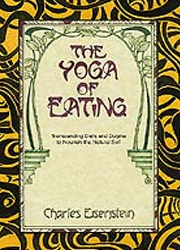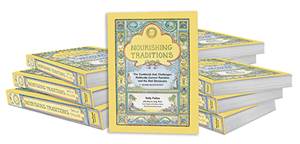Charles Eisenstein
ISBN 0-9670897-2-7
US$13.95
192 pages – 6″ x 9″ – B/W illustrations
Transcending Diets and Dogma to Nourish the Natural Self
These are confusing times for the health conscious consumer — hundreds of conflicting diets competing for public attention, each backed by authoritative advocates and compelling testimonials. Which diet is correct? Which authority should we believe? Which sources of information can we trust?
The Yoga of Eating presents a wholly new approach, a path of self-trust and self-exploration. This book does not tell you what to eat and what not to eat. It is not a book about nutrition, nor is it about “yogic diet.” Instead it is a practical and inspiring manual that explains how to
- Distinguish superficial cravings from authentic appetites, to give your body the nourishment it needs
- Bring your diet into alignment with who you are, and who you wish to be
- Choose from among the hundreds of diets on the market to identify which comes closest to meeting your unique needs
- Transform the delight and pleasure of eating into an ally in the quest for health
- Build trust in your natural body and natural self
The Yoga of Eating offers original insights on the physical and spiritual functions of sugar, fat, meat, and other foods; fasting, dieting, processing, willpower, and the deeper principles of self-nurture. Dispensing with conventional doctrine, this book appeals to a higher authority—your own body—and shows how to access and trust the wisdom your body has to offer.
C H A R L E S E I S E N S T E I N
 After graduating from Yale University with a degree in Mathematics & Philosophy, Charles Eisenstein spent most of the next ten years in Taiwan, where he was one of that country’s leading Chinese-English translators and editor of several publications. There he also became acquainted with traditional Asian arts and religious disciplines. Mr. Eisenstein currently teaches part-time in two departments at Penn State University. Occasionally he serves as an organizational consultant and spiritual counselor; he also leads workshops on the topics of breath and food. He lives in central Pennsylvania with his wife and two children, and despite the above, really isn’t very busy.
After graduating from Yale University with a degree in Mathematics & Philosophy, Charles Eisenstein spent most of the next ten years in Taiwan, where he was one of that country’s leading Chinese-English translators and editor of several publications. There he also became acquainted with traditional Asian arts and religious disciplines. Mr. Eisenstein currently teaches part-time in two departments at Penn State University. Occasionally he serves as an organizational consultant and spiritual counselor; he also leads workshops on the topics of breath and food. He lives in central Pennsylvania with his wife and two children, and despite the above, really isn’t very busy.



